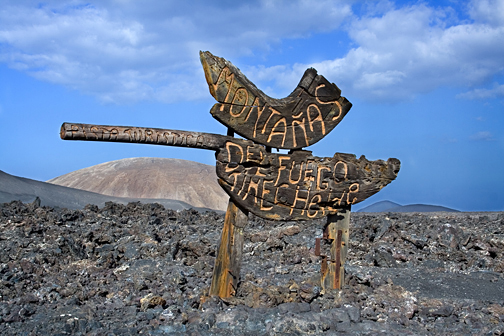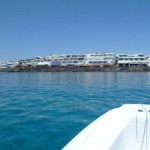Las Montañas del Fuego (The Fire Mountains) in Lanzarote

The Montañas del Fuego (Fire Mountains) or Timanfaya form part of a broad area affected by the volcanic eruptions that struck Lanzarote between 1730 and1736, with subsequent eruptions in 1824.
This long eruptive process ? one of the most relevant and spectacular in the Earth’s volcanic history ? drastically changed the island’s morphology, leaving a quarter of it almost completely buried under a thick layer of lava and ash.
The volcanic landscape produced by such volcanic activity includes a total perimeter of 174 Km2, although the area protected as the Timanfaya National Park only covers an area of 51 Km2, whether the most important eruptions occurred.
There are numerous documentary historical accounts that describe the volcanic phenomena that occurred on the island. Without doubt, the best-known is the account given by the priest in Yaiza, Don Andrés Lorenzo Curbelo, which was reproduced by the German geologist Leopold Von Buch in 1825 in his book «Physical Description of the Canary Islands».
«On the first of September 1730, says Don Lorenzo Curbelo, between 9 and 10 o’clock at night, the earth suddenly opened close to Timanfaya, two leagues from Yaiza. On that first night, an enormous mountain rose up from the heart of the earth, and from its summit there escaped flames that continued to burn for nineteen days (…) They were accompanied by a great quantity of lapilli, dust and ash that spread over the surrounding areas and from all sides drops of water fell as rain. The thunderclaps and explosions that accompanied those phenomena, the darkness caused by the mass of ash and smoke that covered the island, forced the inhabitants to flee more than once…»
The Islote de Hilario
All along Timanfaya, there are what vulcanologists call «geothermic anomalies»: unusual temperatures in the earth’s surface coming from the subsoil, actually from a residual chamber of magma close to the surface. The main centre of these anomalies is located on the Islote de Hilario, where its effects are shown to curious visitors by the famous geysers, the combustion of gorse or by cooking food using the earth’s natural heat.
This part of Timanfaya takes its name from the Lanzaroteño known as Hilario, a character from Lanzarote legend, who lived here like a hermit after the Spanish-American War in the Philippines, with only his camel for company. Hilario planted a fig tree which, though it grew, never bore fruit because «flowers could not feed on flames».
Inside the Restaurante «El Diablo», there is a unique work of art: an artificial glass «soco» containing camel bones and a fig tree on top of the black volcanic ash. This is an homage to the legend of Hilario.
Restaurante «El Diablo»
In the Islote de Hilario, we find the artistic influence of César Manrique at the Restaurante «El Diablo». Completed in 1970, this solid building has a circular floor with glass walls that illuminate the interior and act as a kind of mirador looking out over the volcanic landscape. On the exterior ? which is also curved – there is a wall marking the entrance. The architectonic whole is covered in dry, carved stone, enhancing the dark tonalities of the volcanic material.
César uses a profusion of circular, sinuous shapes, for both architectonic and ornamental reasons, in a clear allusion to the traditional «socos» that are used to protect plants from the constant winds.
Located in strategic positions in the Montañas del Fuego, we can see the figure of a devil made of rusted iron. This archetypal symbol of Timanfaya, created by César Manrique, forms an inextricable part of the tragic yet sublime nature seen in the island’s volcanic landscapes.
The «Ruta de los Volcanes» (The Volcano Trail)
Within the National Park, there is a 14-kilometre route for visitors. The trail, which fits perfectly into its surroundings, runs along the main centre of the eruptions, where there is a concentration of singular elements of great geological and geomorphic interest, such as hornitos, caves and malpaíses.
The extreme fragility of the surroundings made it necessary to create a pathway that would be capable, within minimum human intervention, to synthesise their beauty and magnitude. The Ruta de los Volcanes was completed under the supervision of César Manrique and Jesús Soto in 1968.
The «Echadero de Camellos» (The Camels’ Resting Place)
Just as important as the geological phenomena themselves is the way of showing them! Visited since the 19th century by travellers and scientists, there is a deep-rooted culture amongst the Lanzaroteños of making this once-in-a-lifetime visit absolutely unique. The camel rides on the volcano are, without doubt, one of the most classic aspects of Lanzarote and combine the exoticism of the transport with the spectacular nature of the surroundings.
Timanfaya received over 1.5 million visitors every year; together with the Parque Nacional de las Cañadas del Teide ? they are Spain?s most visited National Parks. This represents an important source of revenue for the island’s economy.
Valid Fee from 1st May 2017
Adult: 10,00 euros – 20% off from 15:00 h.
Children: 5,00 euros (7 – 12) – 20% off from 15:00 h.
Canarian Adult Resident: 8,00 euros
Canarian Child Resident: 4,00 euros
Residents in Lanzarote: 2.00 euros
*Due to difficulties when connecting to the internet in this area, card payments are not accepted at the Box Office.
Discount for people with disabilities:
30% discount off tickets to visit the centre by submitting the corresponding certificate at the tickets office.


























